Want a step-by-step guide on how to get started with hydroponics? Check out this comprehensive guide.
Here at Herb Examiner, we’re always looking for the latest advancements in gardening techniques & technology.
However, our topic today, hydroponics – a technique for growing plants without soil – is by no means a new form of gardening; the earliest work on hydroponics was published in 1627 by Francis Bacon; the book, Sylva Sylvarum, has a detailed compendium on Bacon’s approach to water culture.
So even though hydroponics isn’t necessarily new, a lot of highly innovative and really fascinating soil-less growing equipment has popped up onto the market over the last few years.
So, in this article, we’re going to comprehensively break down the best Hydroponic herb gardening techniques, systems, and technology.
Table of Contents:
- The Benefits of Hydroponics
- Best Growing Mediums
- Best Herbs for Hydroponics
- Hydroponic Techniques
- Best Hydroponic Herb Gardens
Benefits of Hydroponic Herb Gardening
- No Soil: Gardening can be a real problem for those of us who A.) want to grow indoors and B.) find soil too expensive or too difficult to grow with. Hydroponics is (usually) a much cleaner endeavor.
- Easy to Control Nutrient Flow: Hydroponics is a lot like driving with a manual transmission, you have direct control of the levers. You can closely monitor your plant’s nutrient intake and adjust when needed. This is obviously much harder to do with conventional gardening.
- No Wasted Water: Hydroponic growing wastes little to no water; you can simply recycle it continuously. No need to fret over the water bill!
- Healthier Yields: Hydroponics is all about control. You control your herb’s nutrient intake, water consumption, and most importantly, the environment. This eliminates the threat of pests and MOST diseases that ravage outdoor, soil-grown herbs.
- Larger Yields: Hydroponics is the best way to quickly grow a large yield of herbs indoors all year long.
Hydroponics is radically different than conventional gardening.
Instead of soil, hydroponic growing methods use 1.) a neutral growing medium and 2.) a nutrient-rich solution.
Plant roots are carefully placed into the neutral growing medium and slowly fed the nutrient-rich solution over a period of time.
The Best Growing Mediums for Hydroponics
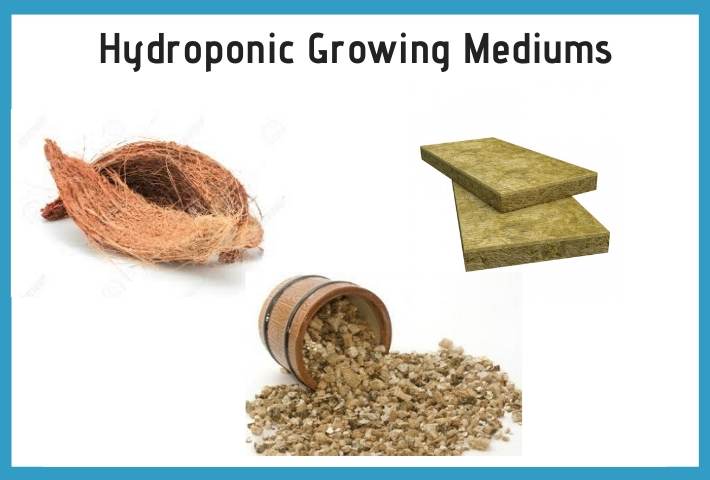
Keep this in mind: There is no one ‘best’ growing medium for hydroponics. In fact, it’s best to use certain growing mediums for certain hydroponic designs – for example, vermiculite acts as a great growing medium for drip hydroponic systems – more on this later.
There are four different hydroponic growing methods that I routinely use and have seen the best results from:
- Coconut Coir: A substance that is literally torn from the insides of a coconut; this growing medium has a very high water-holding capacity, it does a great job at balancing both pH and EC, and is ideal for retaining nutrients. Coconut coir is my favorite growing medium overall.
- Rockwool: A highly flexible and water-retentive medium that has been used for decades; Rockwool is also a very resilient material – it’s exceedingly difficult to break down – this is ideal for hydroponics as loose or detached material can completely destroy a hydroponics unit.
- Vermiculite & Perlite: Are a highly dynamic growing medium duo. Vermiculite can retain an enormous amount of moisture (roughly 200% – 400%) whereas Perlite doesn’t absorb moisture at all. Why does this combination work so well? Perlite allows plant roots to aerate while vermiculite acts as a sponge for the nutrient solution.
Best Nutrient-Rich Solutions for Hydroponics
- General Hydroponics GH5100 General Organics Go Box: I’m all about complete solutions and with the General Hydroponics Go Box you get exactly that: the complete solution. This kit contains two 16 oz. bottles of BioThrive Grow and Bloom Fertilizers along with multiple 8 oz. bottles of every GO liquid supplement that General Hydroponics sells.
- Fox Farm Grow Big Hydro Liquid Concentrate Fertilizer: Another great nutrient solution that provides all the micro-nutrients needed to get growing immediately.
Best Herbs for Hydroponics
Most herbs can be grown effectively with hydroponic systems – you can be as ambitious as you want to be.
With that being said, it’s always best to start small and work your way up.
When starting out with hydroponics, I recommend choosing small, quick-growing herbs that are generally low maintenance.
Here are some good ones to start with:
- Basil
- Chamomile
- Chervil
- Chives
- Cilantro
- Marijuana (if legal)
- Dill
- Lavender
- Marjoram
- Oregano
- Rosemary
- Tarragon
- Thyme
- Mint
- Parsley
Hydroponic Techniques
The chart below lists the 5 most popular hydroponics techniques and ranks them by difficulty and expense.
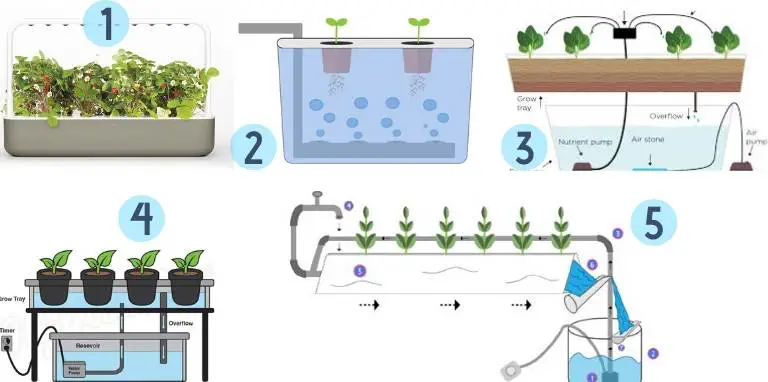
| Technique | Difficulty | Average Price | Overall Score |
|---|---|---|---|
| 1. Aeroponics | 2/10 | $$ | 98% |
| 2. Deep Water Culture | 4/10 | $ | 93% |
| 3. Drip | 6/10 | $$$ | 91% |
| 4. Ebb & Flow | 8/10 | $$ | 93% |
| 5. Nutrient Film | 8/10 | $$$ | 90% |
Of course, expenses and effort will vary by growing ambition, but as a general indicator, this table is an accurate look at hydroponic techniques and their value to beginning growers.
1. Aeroponic Systems
Aeroponic growing techniques are perhaps the most technically advanced, easy to use, and convenient hydroponic growing techniques in use.
These systems use very little to no growing medium; instead, they spray the nutrient solution directly onto the suspended plant roots.
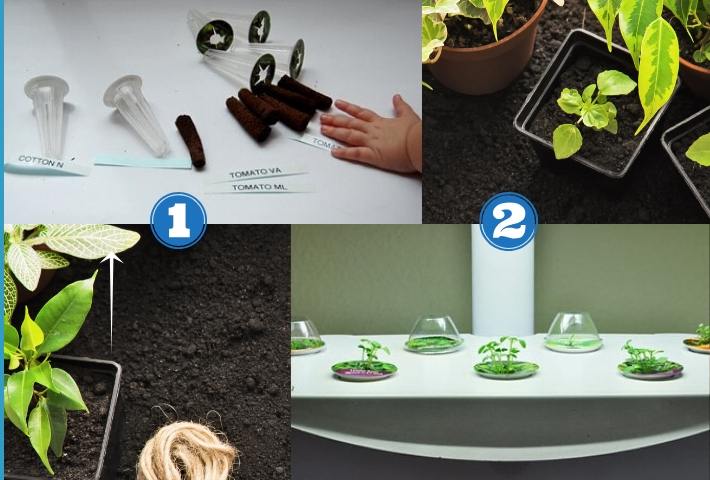
- Commercial Aeroponic systems use these plastic seed pods where both the growing medium and the seeds are compacted together.
- The plants will then grow suspended over the aeroponic reservoir where plant roots will have access to plenty of air and nutrient solution.
D.I.Y. Instructions: aeroponicsdiy
2. Deep Water Culture
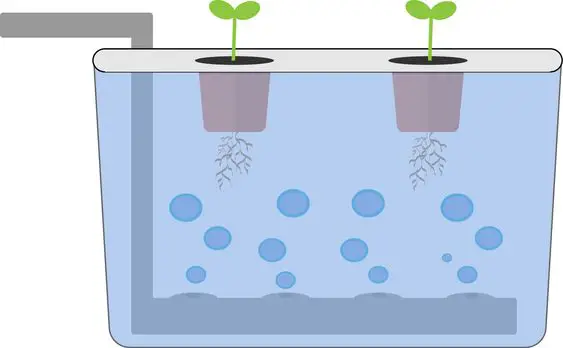
Deep Water Culture is one of the most inexpensive and popular hydroponic techniques.
The basics are very simple: plants are planted within a container with holes, the roots float within the nutrient solution and are supported by a growing medium.
If you’re brand new to hydroponics, a deep water culture unit might be the best system to start with.
You can create your own for less than $20.
Recommended Deep Water Culture Units for Sale: Viagrow VRDWC-4 Recirculating Deep Water Culture
3. Drip Technique
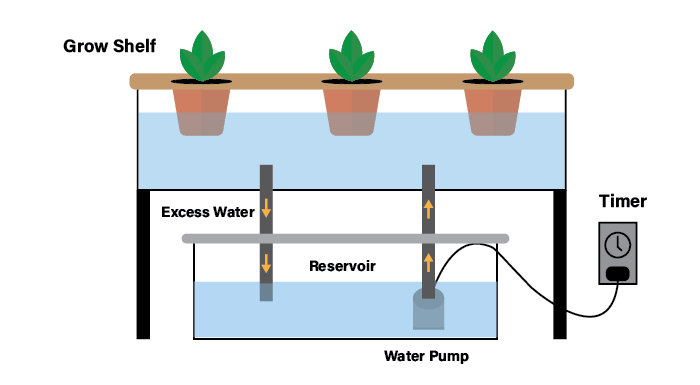
Core Equipment: 1.) Submerged Pump 2.) Automatic Timer 3.) A Plastic Tub 4.) Pipes
Similar to the Deep Water Culture technique, the drip technique is fairly straight-forward.
A submerged pump – which is coupled to a timer – is connected to a series of pipes that are dunked into the base of the plant.
In order for the drip technique to work correctly, the pump should be automatically triggered by the timer to provide the correct amount of nutrient solution to the plant throughout the day.
D.I.Y Instructions: hydroponics-simplified
Recommended Drip Technique Units for Sale: General Hydroponics EcoGrower
4. Ebb & Flow Technique
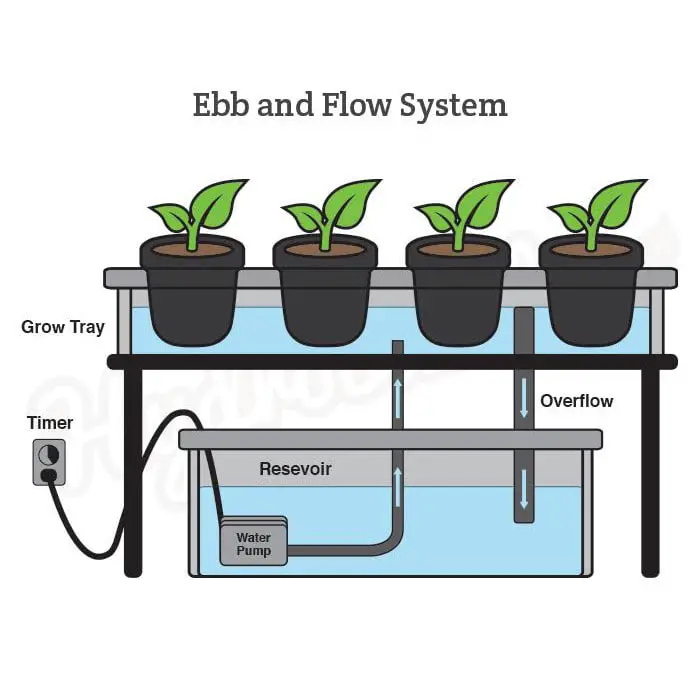
Core Equipment: 1.) Growing Tray 2.) Submerged Pump 3.) Automatic Timer
The Ebb & Flow Technique is based around flooding a grow tray with a nutrient-rich solution for a set period of time.
Once the timer stops, so does the flooding and the nutrient-rich solution flows right back into the reservoir – efficient!
D.I.Y. Instructions: just4growers
Recommended Ebb & Flow Units for Sale: Active Aqua Grow Flow Ebb & Grow
5. Nutrient Film Technique
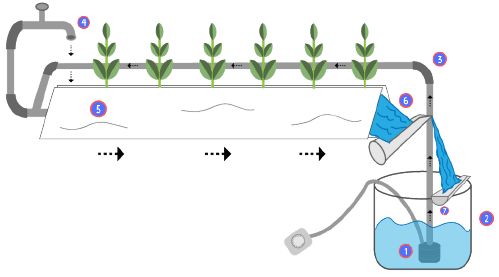
Core Equipment: 1.) Vinyl Downspout 2.) Irrigation tubing 3.) Submersible Water Pump 4.) Net Cups 5.) Zip Ties
The nutrient film technique doesn’t use a timer as it is based around the constant flow of nutrient-rich solution to the plant roots. However, a submersible pump is needed as it provides that constant flow.
Most of the nutrient solution is then sent to a tube which is positioned under the grow tray.
D.I.Y. Instructions: instructables
Recommended Nutrient Film Technique Hydroponic Units for Sale: DreamJoy Hydroponic Grow Kit
The Best Hydroponic Herb Gardens
There are many affordable hydroponic units on the market that are sufficient for both large and small scale herb gardening.
This list will focus on entry-level hydroponic systems that are easy to set up, easy to maintain, and most importantly, systems that grow healthy yields quickly.
The following table lists the best indoor hydroponic herb kits by growing-space and overall performance:
| Model | Grow Space | Score |
|---|---|---|
| 1. AeroGarden Bounty | 9 Plants | 98% |
| 2. Click and Grow Smart Garden 9 | 9 Plants | 94% |
| 3. AeroGarden Harvest | 6 Plants | 88% |
| 4. Go Grow Hydroponic Gardening Planter | 4 Plants | 85% |
| 5. Click & Grow Smart Garden 3 | 3 Plants | 75% |
| 6. AeroGarden 7 | 7 Plants | 83% |
| 7. COLMO Herb Garden Kit | 3 Plants | 77% |
| 8. AeroGarden Farm XL | 24 Plants | 97% |
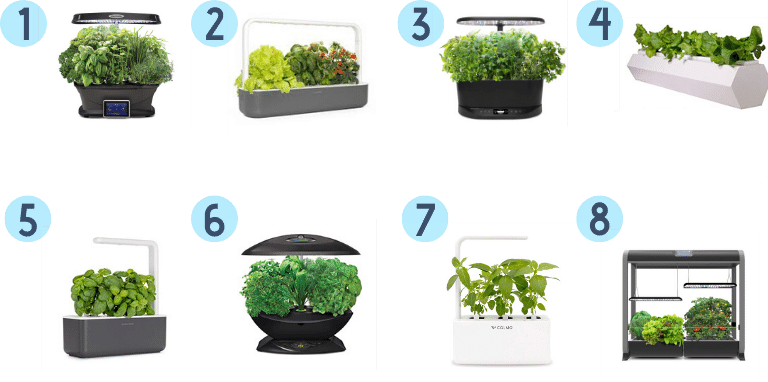
The hydroponic kits above are fully automated; they require minimal maintenance and upkeep.
1. AeroGarden Herb Kits
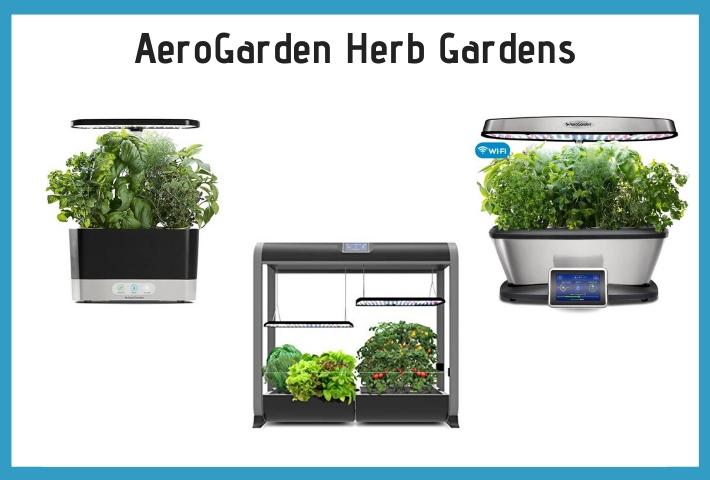
AeroGarden kits are the gold standard in commercial hydroponic gardens.
As I mentioned above, these kits are a product of aeroponics. The roots are suspended in air, held by the herb pods, and are misted with nutrient solution automatically.
It’s also worth noting that Aerogarden sells a wide variety of different seeds – from salad greens to Oregano and thyme, and even strawberries.
I’ve been an avid AeroGarden user for years and I cannot overstate how effective these kits are!
2. Deep Water Culture Hydroponic Systems
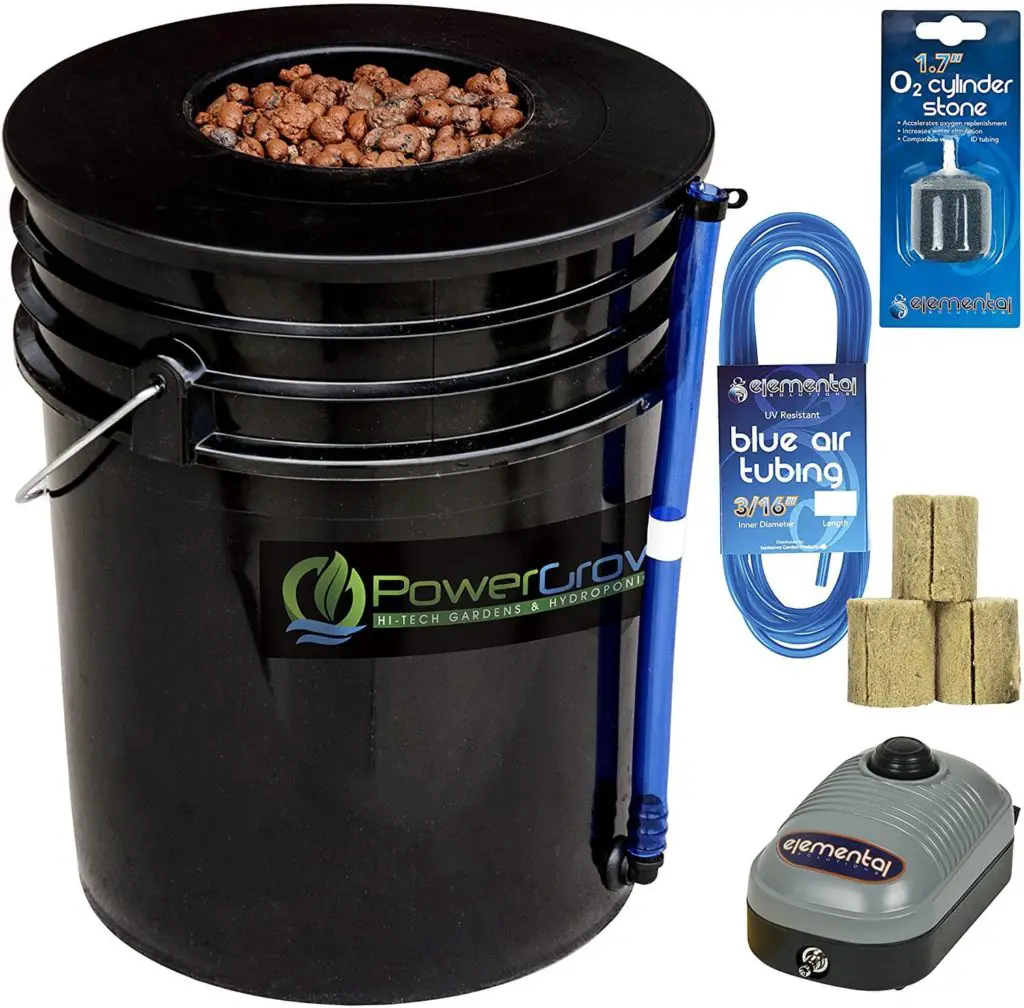
There are many high-quality Deep Water Culture hydroponic systems on the market; my personal favorite is this unit by PowerGrow Systems.
First off, it’s inexpensive.
For less than $40.00 you get 5 buckets, a 44 GPH Air Pump, Air Tubing, and Rockwool Growing Medium.
It’s the perfect entry-level system for beginners who just want to get their feet wet.
3. Vertical Herb Garden Kit
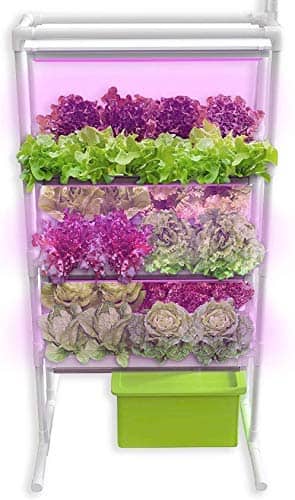
This Vertical Herb Garden Kit takes after the nutrient film technique.
It comes with an airstone growing medium, air pump, water bucket, water indicator, tubing, and nutrients.
This is another solid unit for hydroponic beginners – especially beginners with large aspirations. Using a vertical system like this could prepare you for a full-scale Nutrient Film Technique system down the road.
